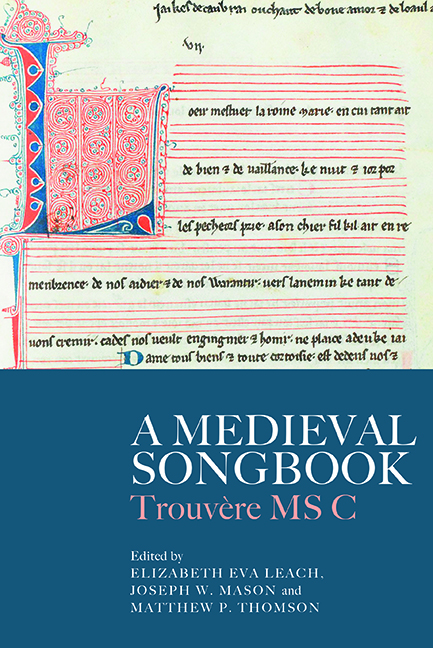Book contents
- Frontmatter
- Contents
- List of Illustrations
- List of Music Examples
- List of Tables
- List of Contributors
- Acknowledgements
- Abbreviations
- Editorial Practices
- Introduction
- Chapter 1 The Trouvère Manuscripts of the Burgerbibliothek Bern
- Chapter 2 The Lorraine Repertoire of C
- Chapter 3 Chansonnier C: Contents, Stemmatic Position, Particularities
- Chapter 4 A Note on the Decoration of C and its Artistic Context
- Chapter 5 Author Ascriptions and Genre Labels in C
- Chapter 6 Common Exemplars of U and C
- Chapter 7 Shared Small Sources for Two Early Fourteenth-Century Metz Chansonniers?
- Chapter 8 The Legacy of Thibaut de Champagne in C
- Chapter 9 Strategies of Appropriation in Jacques de Cambrai's Devotional Contrafacts
- Chapter 10 Jeux-Partis and their Contrafacts in C
- Chapter 11 C and Polyphonic Motets: Exemplars, Adaptations, and Scribal Priorities
- Appendix: List of Songs in C
- Bibliography
- Index of Sources
- Index of Songs
- General Index
- Studies in Medieval and Renaissance Music
Chapter 3 - Chansonnier C: Contents, Stemmatic Position, Particularities
Published online by Cambridge University Press: 26 May 2022
- Frontmatter
- Contents
- List of Illustrations
- List of Music Examples
- List of Tables
- List of Contributors
- Acknowledgements
- Abbreviations
- Editorial Practices
- Introduction
- Chapter 1 The Trouvère Manuscripts of the Burgerbibliothek Bern
- Chapter 2 The Lorraine Repertoire of C
- Chapter 3 Chansonnier C: Contents, Stemmatic Position, Particularities
- Chapter 4 A Note on the Decoration of C and its Artistic Context
- Chapter 5 Author Ascriptions and Genre Labels in C
- Chapter 6 Common Exemplars of U and C
- Chapter 7 Shared Small Sources for Two Early Fourteenth-Century Metz Chansonniers?
- Chapter 8 The Legacy of Thibaut de Champagne in C
- Chapter 9 Strategies of Appropriation in Jacques de Cambrai's Devotional Contrafacts
- Chapter 10 Jeux-Partis and their Contrafacts in C
- Chapter 11 C and Polyphonic Motets: Exemplars, Adaptations, and Scribal Priorities
- Appendix: List of Songs in C
- Bibliography
- Index of Sources
- Index of Songs
- General Index
- Studies in Medieval and Renaissance Music
Summary
The feedback on one's work can be both gratifying and mortifying at the same time. We derive from it both retrospective satisfaction from meticulous work and the regret of committed omissions, even errors, which become obvious when one has a fresh perspective on pages that one has rewritten and modified so many times that it has become impossible to control everything. I am therefore taking advantage of the opportunity offered to me to suggest a critical re-reading of my youthful work on C for the ‘Intavulare’ series, informed by more recent work, in particular that of Madeleine Tyssens on the closely related chansonnier, U. Nonetheless, with a few exceptions, many of the elements that I will mention in thispaper reiterate my earlier description of the codex, which remains, in my opinion, mostly legitimate.
The first special feature of chansonnier C is its complex and refined architecture. The succession of pieces in alphabetical order – a particularity that this manuscript shares only with chansonnier O in the French domain – is the most visible aspec of this architecture, the other salient aspect being the disposition of the religious pieces at the beginning and end of almost all the alphabetical sections. The combination of these two criteria for the assembly of the collection gives a rare value to this manuscript and leads to myriad questions on the process that led to the compilation of this vast ensemble of 520 pieces (four of which are duplicates), including a huge number of unica. The alphabetical collection testifies to such a perfect mastery of the corpus available to the copy shop that one wonders about the compilation method employed, the sources, and how the huge quantity of collected texts was subordinated to the ambition of thoroughness that presides over the whole work.
Nonetheless, let us proceed in order and take a moment to consider the particular cases which permit a glimpse of the dynamic process of C 's construction, behind the fixed aspect of the compiled manuscript.
It is important to note that the grouping of songs by alphabetical sections – from A to U/V – does not match the codicological volume units.
- Type
- Chapter
- Information
- A Medieval SongbookTrouvère MS C, pp. 44 - 51Publisher: Boydell & BrewerPrint publication year: 2022



